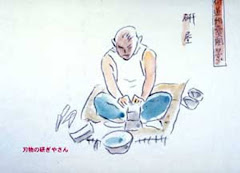Here's a vintage knife that came in for the full refurb. It's a c. 1879-1928 American Cutlery Co. Chicago slicer.
The owner asked that I fix the edge chips, correct the profile, & thin the blade while retaining the maker's mark (which was very lightly done). He also wanted a handle mounted too since apparently knives feel better in the hand with these things. He asked to maintain the full tang if at all possible, and supplied the wood.
The job went well except for the tang as it was just way too thin at the ass end (it was super tapered - the major problem here) and way too thick at the choil with many ups and downs in between. Even though I tried my best to save it I finally had to give up and grind it down. I then tried my best to replicate the feel and shape the tang but I sure do wish that I could have saved it none the less.
On the blade finish, I made a conscious decision to leave behind some of the original battle scars on both sides of the blade, sort of like leaving some history to it. It felt wrong to erase it's past completely.
In the end this knife feels great in the hand and surprisingly the blade gets STUPID sharp so I'm sure that the owner will enjoy using it. :)
Monday, January 27, 2014
Monday, January 13, 2014
Dishwashers + Custom Knife Handles = Don't Mix
I just got finished working on a rehabilitation of a custom handled Artisan gyuto that was sent through the dishwasher by mistake.
I had done the initial rehandle on this knife in a premium AZ Ironwood Burl and thankfully we went with a wood this hearty as I think most others would have been toast.
The left scale had buckled (shrunk) slightly away from the bolster/tang but all over the wood was reduced in thickness exposing sharp surfaces from the pins and tang as well as some minor cracking was seen at the middle pin. I decided to keep the wood and fill in the gaps & cracks with CA glue and then sand everything flush to see what I had to work with. Surprisingly, little evidence of damage could be seen at this stage so I decided to press forward.
The problem appeared in that the wood was extremely dry, so dry that when sanded I got very little of that orange ironwood like dust and little to no orange oil would appear on a wet rag. I then dunked the handle in a cup of teak oil and was amazed to watch the handle drink this stuff up like a sponge - yes literally - like a sponge. I soaked it for a couple of hours and then went to hand sanding and hand rubbing oil into the surface. I continued on this process for days, over and over again until the handle didn't want anymore oil. I can't say how many coats it took overall, something like 40+.
I finished with two hand rubbed coats of my (new) top secret oil formula-mix and I'm quite pleased with how it turned out. Yes it's not as orange as it once was, it's actually a tad darker too, but overall the look is nice and the feel is buttery smooth which I believe is even better in this respect than it was originally.
Now the owner can once again hang this on the wall (or in his block on the counter) with pride and his wife doesn't have to live with the shame anymore.
Dishwashed
The left scale had buckled (shrunk) slightly away from the bolster/tang but all over the wood was reduced in thickness exposing sharp surfaces from the pins and tang as well as some minor cracking was seen at the middle pin. I decided to keep the wood and fill in the gaps & cracks with CA glue and then sand everything flush to see what I had to work with. Surprisingly, little evidence of damage could be seen at this stage so I decided to press forward.
The problem appeared in that the wood was extremely dry, so dry that when sanded I got very little of that orange ironwood like dust and little to no orange oil would appear on a wet rag. I then dunked the handle in a cup of teak oil and was amazed to watch the handle drink this stuff up like a sponge - yes literally - like a sponge. I soaked it for a couple of hours and then went to hand sanding and hand rubbing oil into the surface. I continued on this process for days, over and over again until the handle didn't want anymore oil. I can't say how many coats it took overall, something like 40+.
I finished with two hand rubbed coats of my (new) top secret oil formula-mix and I'm quite pleased with how it turned out. Yes it's not as orange as it once was, it's actually a tad darker too, but overall the look is nice and the feel is buttery smooth which I believe is even better in this respect than it was originally.
Now the owner can once again hang this on the wall (or in his block on the counter) with pride and his wife doesn't have to live with the shame anymore.
Rehabilitated
Dishwashed
Rehabilitated
Dishwashed
Rehabilitated
Subscribe to:
Comments (Atom)














